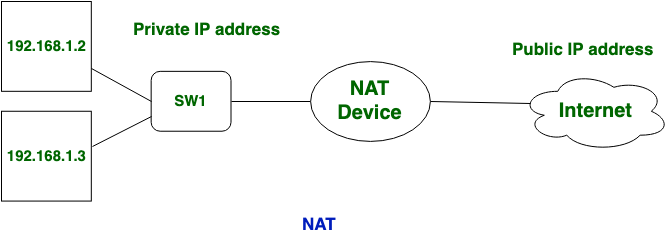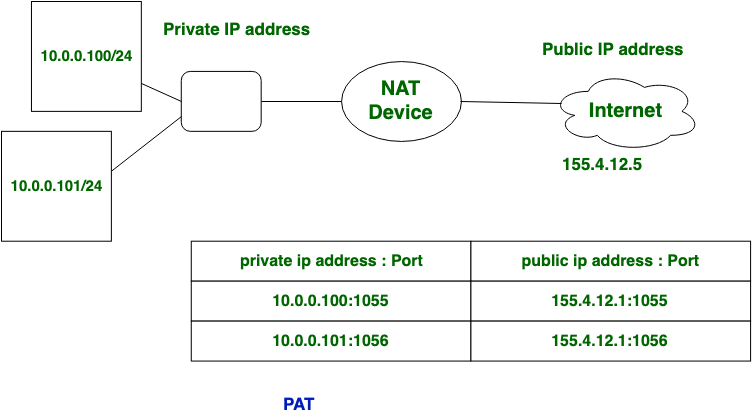Difference Between Network Address Translation (NAT) and Port Address Translation (PAT)
Last Updated :
22 Feb, 2023
Network Address Translation (NAT): NAT, in which the Private IP address or local address is translated into the public IP address. NAT is used to slow down the rate of depletion of the available IP addresses by translating the local IP or Private IP address into a global or public IP address. NAT can be a one-to-one relation or many-to-one relation.

Example:
Consider a home network with three devices: a computer, a smartphone, and a smart TV. Without NAT, each of these devices would need to have a unique public IP address to connect to the internet. However, with NAT, all of these devices can share a single public IP address and communicate with the internet by using their private IP addresses. When one of the devices sends a request to the internet, NAT translates the private IP address of the device into the public IP address of the network and sends the request over the internet.
Port Address Translation (PAT): In PAT, Private IP addresses are translated into the public IP address via Port numbers. PAT also uses IPv4 address but with port number. It have two types:
1. Static
2. Overloaded PAT

Example:
Consider a home network with three devices: a computer, a smartphone, and a smart TV. Without PAT, each of these devices would need to have a unique public IP address to connect to the internet. However, with PAT, all of these devices can share a single public IP address and communicate with the internet by using unique port numbers. When the computer sends a request to the internet, PAT assigns it a unique port number and translates the private IP address of the computer into the public IP address of the network. The destination server on the internet receives the request and responds to the unique port number, allowing the computer to receive the response.
Difference Between Network Address Translation (NAT) and Port Address Translation (PAT):
| Network Address Translation (NAT) |
Port Address Translation (PAT) |
| NAT stands for Network Address Translation. |
PAT stands for Port Address Translation. |
| In NAT, Private IP addresses are translated into the public IP address. |
In PAT, Private IP addresses are translated into the public IP address via Port numbers. |
| NAT can be considered PAT’s superset. |
PAT is a dynamic NAT. |
| NAT uses IPv4 address. |
PAT also uses IPv4 address but with port number. |
| It have 3 types: Static, Dynamic NAT and PAT/ NAT Overloading/IP masquerading. |
It also have two types: Static and Overloaded PAT. |
Role of NAT and PAT in making internet routing efficient:
- NAT and PAT can improve security: NAT can help to improve security by hiding the private IP addresses of devices on a private network from the internet. This can make it more difficult for malicious actors to target specific devices on the network, as they would not be able to see the private IP addresses of the devices. PAT can also help to improve security by allowing devices on a private network to communicate with the internet using unique port numbers, which can make it more difficult for attackers to gain access to the network.
- NAT and PAT can improve performance: NAT and PAT can also improve performance by allowing devices on a private network to share a single public IP address. This can help to reduce the number of routing entries in the routing table of the router, which can improve the efficiency of internet routing.
- NAT and PAT have limitations: While NAT and PAT can help to make internet routing more efficient, they do have some limitations. NAT can cause issues with certain types of internet applications that rely on end-to-end communication, such as Voice over IP (VoIP) and online gaming. PAT can also cause issues with certain types of internet applications that rely on multiple connections, such as BitTorrent.
- NAT and PAT are used in combination: NAT and PAT are often used in combination to make internet routing more efficient. For example, a corporate network may use NAT to allow multiple devices on the network to share a single public IP address, and then use PAT to allow multiple devices to communicate with the internet using unique port numbers.
- IPv6 addresses can alleviate the need for NAT: NAT and PAT are primarily used to address the shortage of available IPv4 addresses. However, with the increasing adoption of IPv6 addresses, which are a newer type of IP address with a much larger address space, the need for NAT and PAT may decrease in the future.
NAT and PAT are not the only technologies for improving internet routing efficiency: There are other technologies that can also help to make internet routing more efficient, such as network address aggregation, network address translation – protocol translation (NAT-PT), and carrier-grade NAT (CGN).
Share your thoughts in the comments
Please Login to comment...